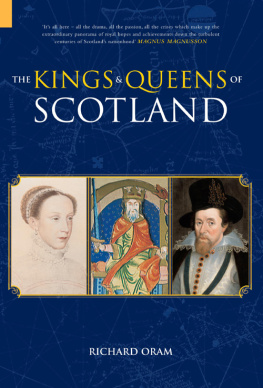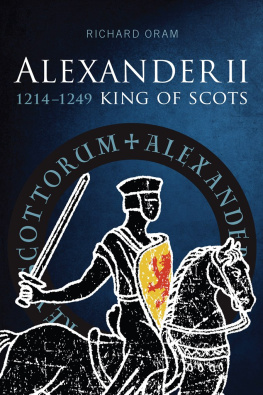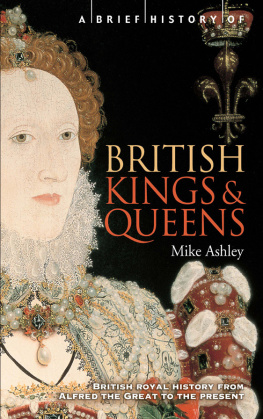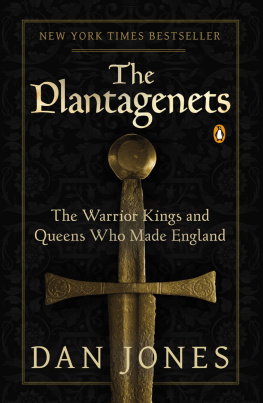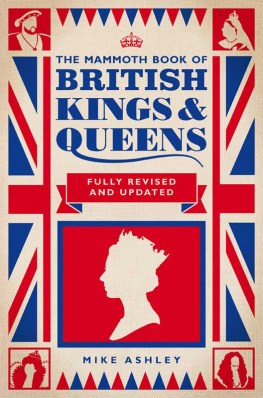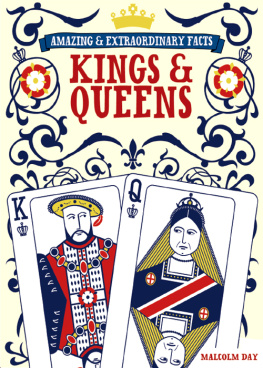Richard Oram - Kings & Queens of Scotland
Here you can read online Richard Oram - Kings & Queens of Scotland full text of the book (entire story) in english for free. Download pdf and epub, get meaning, cover and reviews about this ebook. year: 2011, publisher: The History Press, genre: Art. Description of the work, (preface) as well as reviews are available. Best literature library LitArk.com created for fans of good reading and offers a wide selection of genres:
Romance novel
Science fiction
Adventure
Detective
Science
History
Home and family
Prose
Art
Politics
Computer
Non-fiction
Religion
Business
Children
Humor
Choose a favorite category and find really read worthwhile books. Enjoy immersion in the world of imagination, feel the emotions of the characters or learn something new for yourself, make an fascinating discovery.
- Book:Kings & Queens of Scotland
- Author:
- Publisher:The History Press
- Genre:
- Year:2011
- Rating:4 / 5
- Favourites:Add to favourites
- Your mark:
- 80
- 1
- 2
- 3
- 4
- 5
Kings & Queens of Scotland: summary, description and annotation
We offer to read an annotation, description, summary or preface (depends on what the author of the book "Kings & Queens of Scotland" wrote himself). If you haven't found the necessary information about the book — write in the comments, we will try to find it.
Kings & Queens of Scotland — read online for free the complete book (whole text) full work
Below is the text of the book, divided by pages. System saving the place of the last page read, allows you to conveniently read the book "Kings & Queens of Scotland" online for free, without having to search again every time where you left off. Put a bookmark, and you can go to the page where you finished reading at any time.
Font size:
Interval:
Bookmark:

THE EDITOR & CONTRIBUTORS
RO Dr Richard Oram, University of Stirling
MP Dr Michael Penman, University of Stirling
CM Dr Christine McGladdery, University of St Andrews
MM Dr Maureen Meikle, University of Sunderland
THE EDITOR
R ICHARD O RAM is Lecturer in Medieval Scottish History and
Environmental History at the University of Stirling, editor of History Scotland the popular Scottish history magazine, and editor of Tempuss Scottish Monarchs royal biography series. His other books include Lordship of Galloway, Scottish Prehistory and David I: The King Who Made Scotland, also published by Tempus.
THE CONTRIBUTORS
C HRISTINE M C G LADDERY is Honorary Lecturer at the University of St Andrews, her other books include James II.
M AUREEN M. M EIKLE is Senior Lecturer in History in the School of Humanities and Social Sciences at the University of Sunderland. She was co-editor, with Elizabeth Ewan, of Women in Scotland c.1100-c. 1750. She is currently writing Anna, Queen of Scots, for Tempus.
M ICHAEL P ENMAN is Lecturer in History at the University of Stirling.
His books include David II and The Scottish Civil War:
The Bruces & the Balliols & the War for Control of Scotland (Tempus). He is currently researching a new history of the battle of Bannockburn for Tempus.

First published in 2001
This edition first published 2004
The History Press
The Mill, Brimscombe Port
Stroud, Gloucestershire, GL 5 2 QG
www.thehistorypress.co.uk
This ebook edition first published in 2011
All rights reserved
Richard Oram, 2001, 2004, 2011
The right of Richard Oram, to be identified as the Author of this work has been asserted in accordance with the Copyrights, Designs and Patents Act 1988.
This ebook is copyright material and must not be copied, reproduced, transferred, distributed, leased, licensed or publicly performed or used in any way except as specifically permitted in writing by the publishers, as allowed under the terms and conditions under which it was purchased or as strictly permitted by applicable copyright law. Any unauthorised distribution or use of this text may be a direct infringement of the authors and publishers rights, and those responsible may be liable in law accordingly.
EPUB ISBN 978 0 7524 7099 3
MOBI ISBN 978 0 7524 7100 6
Original typesetting by The History Press


T he kingship of the Scots, as a component of the modern British crown, is one of the oldest monarchies in the world. Its origins can be traced with a fair degree of confidence to the early sixth century AD and the kingship of the migrant Scots of Dl Riata in Ulster, who established a kingdom, also named Dl Riata, in the peninsulas and islands of the southwestern Highlands of the country we know as Scotland. While the main purpose of this book is to trace the lives of the men and women, descendants of these first colonist kings, who occupied the throne of Scotland from the mid-eleventh to early eighteenth centuries, it will also explore the processes that brought mastery of the Scottish mainland to these heirs of piratical Irish warlords. In addition, however, it will also chart the histories of the other kingdoms and peoples with whom the Scots shared the north of Britain Britons and Picts who made their own unique contribution to the character and culture of the later kingdom. The first part of the book focuses on the usually violent processes by which the early rulers of the Scots gradually extended their mastery over the northern British mainland. It is a bloody and in places bewildering catalogue of heroes and villains, who almost literally carved their path to the throne and strove to extend their power over the land. From the violence and mayhem of these formative years, however, emerged a powerful monarchy that succeeded in projecting its authority over what we would now recognise as Scotland.
By the thirteenth century, the kings of Scots had emerged as one of the two most powerful rulers in the British Isles, controlling a kingdom that dominated the north of these islands. Having eliminated the last domestic challenges to their position, the later Canmore kings turned their energies towards welding what was still a disunited kingdom into a unified realm. It is testimony to their achievement that when their dynasty died out, the kingdom did not die with them but hung on to its new-found unity and growing sense of national identity in the face of seemingly insuperable threats to its independent status. Scotlands kings provided the nation with a focus that ensured its survival in the face of the ambitions of Englands powerful Plantagenet rulers.
The traumas of the Wars of Independence and the civil wars between the supporters of Balliol and Bruce served to underpin the nations identity in the fourteenth century. The legacy of these events was a fierce chauvinism that took as its focus the Stewart kings. The drive and ambition of that remarkable family saw Scotland emerge as a powerful player on the European stage, re-establishing contacts that led to a cultural cross-fertilisation from which grew the distinctive Scottish cultural identity of the later Middle Ages and Renaissance. The strident nationalism of the fifteenth century, however, gave way to a hard-headed realism in the sixteenth century as Scotland again moved closer politically to its neighbour and Auld inimie, England. It was perhaps the supreme irony of British history that, after centuries of struggle by kings of England to impose their mastery over the northern kingdom, it was a Scottish king who came south to rule as the first monarch of a united realm. It was not, however, a marriage made in heaven and there were several occasions when it seemed that the union would end in acrimonious divorce. In the end, however, it was the very threat of separation that forced both Scotland and England to reconsider their mutual interests, the result being the 1707 Act of Union. Of course, 1707 is not the end of the tale, which is still growing and evolving, but it marked a significant new departure in the history of Scotlands rulers as they moved towards a British and Imperial future. Thus, with the death of Anne, the last of the direct Stewart line to rule in these islands, we come to the end of a story that spans over one thousand years. The words of the earl of Seafield when Scotlands old parliament voted itself out of existence in 1707 are equally appropriate here. Theres ane end of ane auld sang.
In the first chapter, many of the names of the kings and great lords will be unfamiliar to most readers. The forms of the names used are, as close as possible, the Gaelic or Brittonic (the language of the Britons and Picts, akin to modern Welsh) versions by which these individuals would have been known. From the emergence of the Picto-Scottish kingdom of Alba, the names of the rulers are given in Gaelic with the modern anglicised form in brackets afterwards. From the mid-eleventh century onwards, the names are given in their most common modern forms. Place-names are generally given in their modern form, but occasionally older forms are used.
Font size:
Interval:
Bookmark:
Similar books «Kings & Queens of Scotland»
Look at similar books to Kings & Queens of Scotland. We have selected literature similar in name and meaning in the hope of providing readers with more options to find new, interesting, not yet read works.
Discussion, reviews of the book Kings & Queens of Scotland and just readers' own opinions. Leave your comments, write what you think about the work, its meaning or the main characters. Specify what exactly you liked and what you didn't like, and why you think so.

